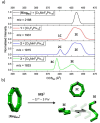Modern Electrospray Ionization Mass Spectrometry Techniques for the Characterization of Supramolecules and Coordination Compounds
- PMID: 38686955
- PMCID: PMC11099892
- DOI: 10.1021/acs.analchem.4c01028
Modern Electrospray Ionization Mass Spectrometry Techniques for the Characterization of Supramolecules and Coordination Compounds
Abstract
Mass spectrometry is routinely used for myriad applications in clinical, industrial, and research laboratories worldwide. Developments in the areas of ionization sources, high-resolution mass analyzers, tandem mass spectrometry, and ion mobility have significantly extended the repertoire of mass spectrometrists; however, for coordination compounds and supramolecules, mass spectrometry remains underexplored and arguably underappreciated. Here, the reader is guided through different tools of modern electrospray ionization mass spectrometry that are suitable for larger inorganic complexes. All steps, from sample preparation and technical details to data analysis and interpretation are discussed. The main target audience of this tutorial is synthetic chemists as well as technicians/mass spectrometrists with little experience in characterizing labile inorganic compounds.
Conflict of interest statement
The author declares no competing financial interest.
Figures






References
-
- de Hoffmann E.; Stroobant V.. Mass Spectrometry: Principles and Applications; John Wiley & Sons, 2007.
LinkOut - more resources
Full Text Sources

